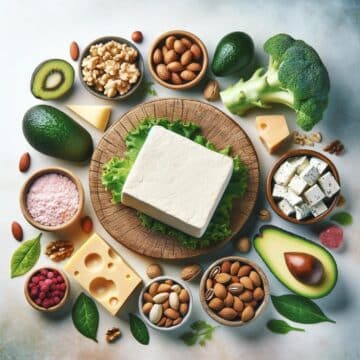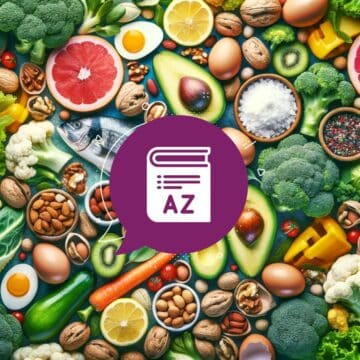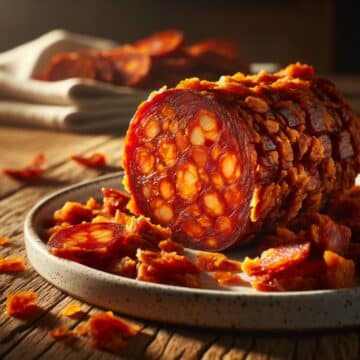Flour, starch, and sugar are the pillars of most baked goods [1], but all three are not allowed on keto (and generally not that good for you).
So, how does a keto eater make healthy brownies, muffins, cake, or bread? By using keto-approved substitutes like nut flours, xanthan gum, and low-carb sweeteners.
But keto baking isn’t as simple as swapping one for the other. Instead, baking involves complex chemical reactions when you make a specific combination of ingredients and expose them to heat.
Recreating that with different ingredients takes a bit of knowledge and practice. And it all starts with the right ingredients.
If you’re new to keto baking or want to level up your game, below are a couple of baking essentials we use in many of our baked goods.

Discovering the World of Keto Baking
Keto baking is the practice of using low-carb substitutions for flour, sugar, and starch when making baked goods like bread, buns, rolls, muffins, and biscuits. It also entails using different baking methods from what’s typically involved in baking.
Instead of grain flour, keto baked goods are made with:
And in place of using sugar, honey, or maple syrup, keto dieters sweeten their desserts with:
- Erythritol
- Stevia
- Monk fruit
- Xylitol
- Allulose
- Yacon syrup
Since these ingredients don’t behave like flour and sugar in baking, it’s essential to use different leavening agents, binders, and methods to make low-carb pastry with a texture as close to the original as possible.
Mastering the Art and Science of Keto Baking
Something to keep in mind is that it takes some practice and experimentation before you get the hang of keto baking. New keto bakers frequently end up with grainy, dense, and weird-tasting baked goods because they’re still navigating this new culinary field. And that’s perfectly normal!
But to avoid throwing away a perfectly good batch of baked goods and make them decent enough, you need to know the science of keto baking. Here are the essentials to help get you started:
Rising
Many baked goods proof and rise with yeast fermentation. Think cinnamon rolls, doughnuts, and yeast dumplings. But keto baked goods can’t rise this way since they miss two critical ingredients for yeast fermentation: sugar and gluten.
Instead, we use baking soda and eggs. Baking soda reacts with acids like lemon juice to form carbon dioxide bubbles in the dough. Egg proteins tend to expand when heated, so they can also help keto doughs rise.
Binding
Gluten works as a binder in most baked goods. It’s a type of protein found in wheat and other grains that forms elastic fibers when mixed with water.
Yeast enzymes convert starch to simple sugars, which the yeast ferment and produce carbon dioxide gas as a byproduct [2]. Gluten helps trap these air bubbles, giving dough its spongy, poofy appearance. Gluten also binds all the other ingredients in baked goods, giving them a chewy texture.
Since keto flours don’t contain any gluten naturally, there are two things you could do: add vital wheat gluten or xanthan gum.
Vital wheat gluten is low in carbs [3], and only a tiny amount is needed in most recipes. It is, obviously, not gluten-free, though. Xanthan gum is a food additive that can replace gluten in most baked goods.
Baking
The tastiest baked goods are evenly baked and mildly browned. Many traditional recipes with wheat flour achieve this with the standard temperature of 350°F (180°C).
The browning of baked goods is due to the Maillard reaction, a chemical reaction that happens when protein and sugars are heated together [4].
Keto flours don’t contain sugar and are high in fat. As a result, they tend to turn out lighter than their traditional counterparts since it’s hard to achieve browning without sugar [5].
Keto baked goods can also end up being dense with the wrong combination of ingredients. Generally, combining high-fat flours with fibrous flours is a good idea to achieve a lighter texture.
Another trick is to bake low and slow — keto-baked goods often need more time and less heat to bake thoroughly.
Flavoring
Flavoring keto desserts is definitely more an art than an exact science. It involves using different sweeteners, spices, and mix-ins to give keto desserts a complexity of flavor.
When choosing your flavorings, you need to first think about their carb count, of course. But it would help if you also considered how flavorings would work with the other ingredients and how to combine them.
Sweeteners seem to be the biggest problem for keto bakers. Many tend to have a bitter, minty, or just strange taste. Others leave a cooling aftertaste. Mixing and pairing them sometimes offsets these things. Adding other flavorings helps with this problem as well.
10 Must-Have Ingredients for Your Keto Baking Pantry
Nut flours, eggs, butter, and cream are keto baking staples. But there are countless other things to make brownies, cookies, and muffins with. So stock your pantry with the best keto baking ingredients described below and for failproof low-carb baking.
Baking powder
Baking powder is a leavening agent made with carbonate or bicarbonate and a weak acid. Many brands of baking powder also contain a small amount of cornstarch to help stabilize the product. However, it’s usually in insignificant amounts, with 1 tablespoon having 1g of net carbs [6].
If you don’t like the idea of using baking powder with cornstarch, starch-free versions are also widely available.
In keto baking, baking powder is the primary leavening agent. It helps muffins, cookies, rolls, and cakes rise and turn out soft and fluffy. It’s often combined with eggs to provide gluten's binding and structuring properties.
Baking soda
Baking soda is just sodium bicarbonate, a salt made up of sodium and bicarbonate atoms. It is usually combined with baking powder to neutralize acidity and provide additional leavening. However, you can use it alone in place of baking powder as well. Just keep these things in mind:
- Use ¼ teaspoon of baking soda for every teaspoon of baking powder. Baking soda is a much more potent leavener, so less is usually needed.
- Add ½ teaspoon of lemon juice when using baking soda alone and if your recipe does not use any other acid.
With baking soda, you don’t have to worry about any hidden carbs, but it may affect the taste of the final recipe.
Cream of tartar
Cream of tartar is a byproduct of winemaking used in baking to stabilize egg whites and whipped cream. It’s also used as an anti-caking ingredient and an acid in baking soda.
Also called potassium bitartrate, cream of tartar is produced from tartaric acid.
In keto baking, cream of tartar can help create poofy bread and pastry where egg whites are the main binding and leavening ingredient. For example, it’s the primary stabilizer in cloud bread and many keto bread recipes. You can also use it when making meringues or macarons.
Cocoa powder
Unlike hot chocolate mix, cocoa powder is keto-friendly and a wholesome ingredient to boot. It’s made by crushing fermented cocoa beans, removing their fat, and grinding them into powder. It has around 1g of net carbs in a tablespoon [7]. However — and this is important — make sure to buy the unsweetened variety.
Cocoa powder is a frequent addition in keto chocolate cakes, brownies, smoothies, and more. You can substitute it for chocolate in a large number of keto desserts or use it in combination with low-carb chocolate.
Cocoa powder not only adds a deep chocolate flavor and aroma, but it’s also loaded with mood-boosting antioxidants and essential minerals [8].
Sugar-free dark chocolate
The darker chocolate, the better it is for keto, especially if it’s also sugar-free. Sugar-free dark chocolate is usually made with quality ingredients, including flavorful cocoa beans. So, if you want to make gourmet-level chocolate cake, choose a quality brand of sugar-free dark chocolate.
There are also many brands to choose from. For example, some brands of bitter chocolate completely exclude sweeteners, while others use stevia and other keto-friendly sweeteners.
Dark chocolate adds a deep and rich flavor and deep brown color to baked goods like chocolate cake, chocolate muffins, and brownies.
Baking chocolate
Most people use baking chocolate in their chocolate desserts. That’s why it’s called that way, after all. Baking chocolate, which is found in the baking aisle in most supermarkets, has a high percentage of cocoa solids and cocoa butter. It’s also usually lower in sugar compared to milk chocolate. These properties allow it to melt evenly in cake and ganache.
However, not all baking chocolate is low-carb. Choose brands that are also labeled sugar-free and don’t contain maltose and other non-keto sweeteners.
Use it in any dessert that calls for cooking chocolate or substitute with dark chocolate.
Chocolate chips
Low-carb chocolate chips were hard to find a couple of years ago. However, countless brands now sell chocolate chips with no added sugar and loads of chocolate flavor nowadays. For example, Bake Believe is a popular brand of semi-sweet and flavored chocolate chips made with no added table sugar.
Chocolate chips are best used as mix-ins in cookies or muffins. You can also add them to breakfast cereal or granola.
However, it’s usually not a good idea to use them in place of cooking or dark chocolate in recipes where chocolate is the main ingredient. Thas is because many don’t contain enough cocoa butter and have stabilizers that help them hold their teardrop shape during baking. These stabilizers can make them hard to melt; additionally, they may become crumbly during baking.
Vanilla extract
It’s hard to imagine baked goods without a splash of vanilla extract. This staple flavoring is aromatic on its own while also enhancing other flavors in baked recipes. In keto baking, it can turn lackluster cookies into something exceptional.
When buying vanilla extract, keep in mind that the real thing is pricey and contains authentic vanilla bean flavor.
Imitation vanilla extracts are usually called vanilla essence and vanilla flavor. These contain a synthetic ingredient that imitates vanilla aroma and is known as vanillin.
While both can work in baked goods, the vanilla extract should be your leading choice in creamy desserts since vanilla aroma can produce a somewhat artificial flavor in these recipes. And, of course, read the label for hidden carbs!
Vanilla
Vanilla extract is made from the vanilla bean, a fruit of the vanilla orchid mostly grown in Madagascar. Unfortunately, vanilla beans are expensive, so genuine vanilla products are also pricier.
Vanilla products include vanilla extract, sugar, paste, powder, and whole pods. Imitation vanilla is also available in many different forms.
Of course, those with added sugar are not keto-friendly, so stick to vanilla extract and whole pods.
The rest of the products are laden with sugar, starch, maltodextrin, and ingredients you don’t want in your keto desserts.
Xanthan gum
Keto bread and other low-carb baked goods can turn out crumbly and dense without a suitable binder.
Xanthan gum, a food additive produced through bacterial fermentation, can make a HUGE difference in how your bread, muffins, bagels, and even pancakes turn out. It is viscous and gel-like, helping thicken mixtures and bring the ingredients together.
While not really natural, Xanthan gum is proven to be safe for human consumption. It’s essentially a complex carbohydrate that acts like other dietary fibers in the digestive tract [9]. In other words, it increases stool bulk, absorbs excess bile and cholesterol, and helps keep blood glucose in check.
Key Takeaways for Successful Keto Baking
Keto baking is easy — you just need to use the right ingredients. Aside from nut flours, butter, nut milk, and other well-known staples, your choice of chocolate, leaveners, flavorings, and binding ingredients is also essential. These can make a big difference in the taste and texture of goods made with nut flours and high-fat ingredients.
Click on the links above to learn more about each individual keto baking ingredient. And feel free to share your keto baking adventures in the comments below.
References:
- Larsen L. The Science Behind Common Baking Ingredients. The Spruce Eats. Nov 2019. https://www.thespruceeats.com/baking-ingredient-science-481226
- Maicas S. The Role of Yeasts in Fermentation Processes. Microorganisms. 2020;8(8):1142. Published 2020 Jul 28. doi:10.3390/microorganisms8081142
- U.S. Department of Agriculture. Agricultural Research Service. FoodData Central. Vital wheat gluten. Apr 2019. https://fdc.nal.usda.gov/fdc-app.html#/food-details/168147/nutrients
- ALjahdali N, Carbonero F. Impact of Maillard reaction products on nutrition and health: Current knowledge and need to understand their fate in the human digestive system. Crit Rev Food Sci Nutr. 2019;59(3):474-487. doi:10.1080/10408398.2017.1378865
- Andersson M. Protein enriched foods and healthy ageing: Effects of almond flour, soy flour and whey protein fortification on muffin characteristics. SP Technical Research Institute of Sweden, Food and Bioscience: 2016: 02. http://www.diva-portal.org/smash/get/diva2:962940/FULLTEXT01.pdf
- U.S. Department of Agriculture. Agricultural Research Service. FoodData Central. Leavening agents, baking powder, double-acting, straight phosphate. Apr 2019.
https://fdc.nal.usda.gov/fdc-app.html#/food-details/172804/nutrients
- U.S. Department of Agriculture. Agricultural Research Service. FoodData Central. Cocoa, dry powder, unsweetened. Apr 2019. https://fdc.nal.usda.gov/fdc-app.html#/food-details/169593/nutrients
- Latif R. Health benefits of cocoa. Curr Opin Clin Nutr Metab Care. 2013;16(6):669-674. doi:10.1097/MCO.0b013e328365a235
- EFSA Panel on Food Additives and Nutrient Sources added to Food (ANS), Mortensen A, Aguilar F, et al. Re-evaluation of xanthan gum (E 415) as a food additive. EFSA J. 2017;15(7):e04909. Published 2017 Jul 14. doi:10.2903/j.efsa.2017.4909






Leave a Reply